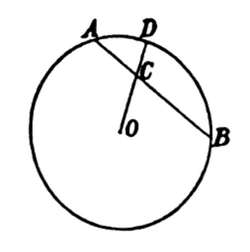Biology:Grassmann's laws (color science)
Grassmann's laws describe empirical results about how the perception of mixtures of colored lights (i.e., lights that co-stimulate the same area on the retina) composed of different spectral power distributions can be algebraically related to one another in a color matching context. Discovered by Hermann Grassmann[1] these "laws" are actually principles used to predict color match responses to a good approximation under photopic and mesopic vision. A number of studies have examined how and why they provide poor predictions under specific conditions.[2][3]
Modern interpretation

The four laws are described in modern texts[5] with varying degrees of algebraic notation and are summarized as follows (the precise numbering and corollary definitions can vary across sources[6]):
| First law: | Two colored lights appear different if they differ in either dominant wavelength, luminance or purity. Corollary: For every colored light there exists a light with a complementary color such that a mixture of both lights either desaturates the more intense component or gives uncolored (grey/white) light. |
| Second law: | The appearance of a mixture of light made from two components changes if either component changes. Corollary: A mixture of two colored lights that are non-complementary result in a mixture that varies in hue with relative intensities of each light and in saturation according to the distance between the hues of each light. |
| Third law: | There are lights with different spectral power distributions but appear identical. First corollary: such identical appearing lights must have identical effects when added to a mixture of light. Second corollary: such identical appearing lights must have identical effects when subtracted (i.e., filtered) from a mixture of light. |
| Fourth law: | The intensity of a mixture of lights is the sum of the intensities of the components. This is also known as Abney's law. |
These laws entail an algebraic representation of colored light.[7] Assuming beam 1 and 2 each have a color, and the observer chooses as the strengths of the primaries that match beam 1 and as the strengths of the primaries that match beam 2, then if the two beams were combined, the matching values will be the sums of the components. Precisely, they will be , where:
Grassmann's laws can be expressed in general form by stating that for a given color with a spectral power distribution the RGB coordinates are given by:
Observe that these are linear in ; the functions are the color matching functions with respect to the chosen primaries.
See also
References
- ↑ Grassmann, H. (1853). "Zur Theorie der Farbenmischung". Annalen der Physik und Chemie 165 (5): 69–84. doi:10.1002/andp.18531650505. Bibcode: 1853AnP...165...69G. https://zenodo.org/record/1423628.
- ↑ Pokorny, Joel; Smith, Vivianne C.; Xu, Jun (1 February 2012). "Quantal and non-quantal color matches: failure of Grassmann's laws at short wavelengths". Journal of the Optical Society of America A 29 (2): A324-36. doi:10.1364/JOSAA.29.00A324. PMID 22330396. Bibcode: 2012JOSAA..29A.324P.
- ↑ Brill, Michael H.; Robertson, Alan R. (2007). "Open Problems on the Validity of Grassmann's Laws" (in en). Colorimetry: Understanding the CIE System. John Wiley & Sons, Inc.. pp. 245–259. doi:10.1002/9780470175637.ch10. ISBN 978-0-470-17563-7.
- ↑ Hermann Grassmann; Gert Schubring (1996). Hermann Günther Grassmann (1809-1877): visionary mathematician, scientist and neohumanist scholar: papers from a sesquicentennial conference. Springer. p. 78. ISBN 978-0-7923-4261-8. https://books.google.com/books?id=PUifpzKWhLkC&q=grassman%27s+second+law+color+linear.
- ↑ Stevenson, Scott. "University of Houston Vision OPTO 5320 Vision Science 1 Lecture Notes". https://www.opt.uh.edu/onlinecoursematerials/stevenson-5320/vis_sci_02.pdf.
- ↑ Judd, Deane Brewster; Technology, Center for Building (1979) (in en). Contributions to Color Science. NBS. p. 457. https://books.google.com/books?id=jgz_iI8NAzYC&q=%22Grassmann%27s+laws%22&pg=PA457. Retrieved 6 January 2018.
- ↑ Reinhard, Erik; Khan, Erum Arif; Akyuz, Ahmet Oguz; Johnson, Garrett (2008) (in en). Color Imaging: Fundamentals and Applications. CRC Press. p. 364. ISBN 978-1-4398-6520-0. https://books.google.com/books?id=suLqBgAAQBAJ&q=grassman%27s+laws+additive&pg=PA364.
 |

